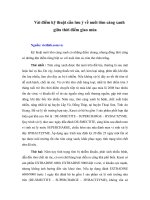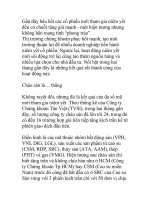Tải Những điểm ngữ pháp cần lưu ý khi thi Đại học - Ngữ pháp Tiếng Anh ôn thi Đại học
Bạn đang xem bản rút gọn của tài liệu. Xem và tải ngay bản đầy đủ của tài liệu tại đây (127.66 KB, 10 trang )
<span class='text_page_counter'>(1)</span><div class='page_container' data-page=1>
<b>NHỮNG ĐIỂM NGỮ PHÁP CẦN LƯU Ý KHI THI ĐẠI HỌC</b>
<b>1/ ĐẠI TỪ</b>
<b>* Đại từ nghi vấn: who, whose, whom, …</b>
- What + be …like? Dùng hỏi tính cách, tính chất
Ex: What was the exam like? – It was very difficult.
What is David like? – He is very sociable.
- What does he/she/it …look like? Dùng hỏi về vẻ bên ngoài
Ex: What does she look like? – She is tall.
- What about + V-ing = How about + V-ing …? Đưa ra gợi ý hoặc đề nghị
- Which (nào, cái nào, người nào)
Ex: Which is your favourite subject?
Ex: Which of these photos would you like?
W Which of us is going to do the washing-up?
Note: + Which chỉ sự lựa chọn trong một số lượng có giới hạn
There’s fruit juice, coffee and tea. Which will you have?
+ What dùng khi có sự lựa chọn rộng rãi
What would you like to drink?
<b>* Đại từ phân bổ:</b>
<b>- All (tất cả): có thể là chủ ngữ, tân ngữ hoặc bổ ngữ</b>
All were eager to leave.
I’ll do all I can.
Wallet, ticket and a bunch of keys, that’s all in his pocket.
All (of) my friends like reading.
All of the money has been spent.
I’m going to invite all of you.
<b>- All of + N (singular) = the whole </b> I’ve eaten all of the cake = I’ve eaten the whole cake.
<b>- Which of + determiner + N (plural)</b>
<b>- Which of + pronoun</b>
<b>- All of + determiner + N (plural/uncountable) + V(plural/singular)</b>
</div>
<span class='text_page_counter'>(2)</span><div class='page_container' data-page=2>
<b>- Most (phần lớn, hầu hết) </b>
Most of the people here know each other.
He spends most of his free time in the library.
Most of us enjoy shopping.
<b>- Each (mỗi)</b>
<b>* Đại từ hỗ tương: là đại từ chỉ mối quan hệ qua lại giữa hai hoặc nhiều người hoặc vật với nhau, gồm each</b>
<b>other và one another </b><i>(nhau, lẫn nhau)</i>
Sue and Ann don’t like each other / one another .
They sat for two hours without talking to each other / one another .
Không dùng each other sau các từ meet, marry và similar.
They married in 1990. (not: They married each other).
<b>2/ DANH TỪ</b>
<b>2.1. Danh từ ghép:</b>
- Là danh từ gồm hai hoặc nhiều từ kết hợp với nhau. Danh từ ghép có thể được viết thành hai từ riêng biệt, có
gạch ngang giữa hai từ hoặc kết hợp thành một từ.
Ex: world peace, non-stop train, writing-table
- Cách thành lập danh từ ghép:
<b>a. Danh từ + danh từ (Noun + noun)</b>
toothpick (tăm) schoolboy tennis ball bus driver river bank
<b>b. Tính từ + danh từ (Adjective + Noun)</b>
quicksilver (thủy ngân) greenhouse (nhà kính) blackbird (chim két)
<b>c. Danh từ + danh động từ (Noun + gerund): chỉ một loại công việc</b>
weigh-lifting (cử tạ) fruit-picking (việc hái quả) <b>coal-mining (việc khai thác than)</b>
<b>d. Danh động từ + danh từ (Gerund + noun)</b>
waiting-room (phòng chờ) swimming pool (hồ bơi)
driving licence (bằng lái xe) washing-machine (máy giặt)
<b>e. Các trường hợp khác:</b>
- Tính từ + động từ: whitewash (nước vơi)
- Động từ + danh từ: pickpocket (tên móc túi)
- Trạng từ + động từ: outbreak (sự bùng nổ)
<b>- Most + determiner + N + V(plural/singular)</b>
<b>- Most of us/you/them + V (plural)</b>
<b>- Each of + determiner + N (plural) + V(singular)</b>
</div>
<span class='text_page_counter'>(3)</span><div class='page_container' data-page=3>
- Động từ + trạng từ: breakdown (sự suy sụp)
- Danh từ + giới từ: passer-by (khách qua đường), looker-on (người xem)
- Danh từ + tính từ: secretary-general (tổng thư ký, tổng bí thư)
<b>2.2 Danh từ số nhiều của những từ có nguồn gốc từ tiếng Hy Lạp hoặc Latin:</b>
<b>Số ít</b> <b>Số nhiều</b> <b>Nghĩa</b>
bacterium bacteria vi khuẩn
curriculum curricula chương trình giảng dạy
datum data dữ kiện
criterion criteria tiêu chuẩn
phenomenon phenomena hiện tượng
basis bases nền tảng
crisis crises cuộc khủng hoảng
analysis analyses sự phân tích
hypothesis hypotheses giả thuyết
<b>2.3 Danh từ đếm được và danh từ không đếm được</b>
* Cách thành lập danh từ số nhiều:
- Thêm –s vào danh từ số ít.
- Thêm –es sau danh từ số ít tận cùng bằng s, ss, sh, ch, x, z, zz.
- Thêm –s nếu trước o là một nguyên âm: radios, micros.
- Thêm –es nếu trước o là một phụ âm: potatoes, tomatoes, heroes.
- Thêm – s nếu trước y là nguyên âm: plays, boys.
- Thêm – es nếu trước y là phụ âm: lorries.
- Danh từ tận cùng bằng f /fe đổi thành –ves: leaf <sub></sub> leaves thief <sub></sub> thieves
- Thêm –s vào sau các danh từ tận cùng bằng f/fe khác: beliefs, cafes .
- Một số từ có số nhiều bất qui tắc:
child – children foot – feet <b>goose – geese</b>
</div>
<span class='text_page_counter'>(4)</span><div class='page_container' data-page=4>
tooth – teeth woman – women sheep – sheep deer – deer
<b>3/ TỪ CHỈ SỐ LƯỢNG:</b>
<b>Với danh từ đếm được</b> <b>Với danh từ không đếm dược</b>
- some/any (một vài) - some/any (một ít)
<b>- many </b> <b>- much</b>
<b>- a large number of</b> <b>- a large amount of</b>
<b>- a great number of</b> <b>- a great deal of</b>
- plenty of - plenty of
- a lot of/lots of - lot of/lots of
- few/a few - little/a little
- every/each
- several (nhiều)
- some: dùng trong câu khẳng định, câu yêu cầu, lời mời, lời đề nghỉ.
- any: dùng trong câu phủ định, nghi vấn.
- many, much dùng trong câu phủ định, nghi vấn.
- a lot of, plenty of, a great number of … dùng trong câu khẳng định.
- many, much ln dùng trong câu khẳng định có các từ very, too, so, as.
- few, little (ít, khơng nhiều): thường có nghĩa phủ định, ít khơng đủ để dùng.
- a few/a little (một vài, một ít): thường có nghĩa khẳng định, ít đủ để dùng.
He drank so much wine that he felt sick.
Would you like some more coffee?
We haven’t got any butter. There aren’t any chairs in the room.
Hurry up! There is little time.
Let’s go and have a drink. We have got a little time before the train leaves.
<b>4/ SỐ CỦA ĐỘNG TỪ: </b>
</div>
<span class='text_page_counter'>(5)</span><div class='page_container' data-page=5>
Three quarters of a ton is too much.
<b>- All, some, plenty + of + danh từ số ít động từ số ít.</b>
<b>- Half, part, a lot, .. + of + danh từ số nhiều động từ số nhiều.</b>
Some of the milk was sour.
A lot of my friends want to emigrate.
<b>- No + danh từ số ít động từ số ít.</b>
<b>- No + danh từ số nhiều động từ số nhiều.</b>
No people think alike.
No student has finished their assigmnet.
<b>5/ LIÊN TỪ (Conjunctions).</b>
a. Liên từ kết hợp: dùng để nối từ, cụm từ hoặc mệnh đề độc lập có cùng chức năng ngữ pháp: and, but, or, nor,
so, yet (tuy nhiên, nhưng), for (vì)
The new method is simple, yet effective.
I told her to leave, for I was very tired.
- Liên từ tương quan: not only … but also, both … and, either … or, neither …. nor, whether …or (có … hay),
Peter neither spoke nor did anything.
I have not decided whether to travel abroad or buy a new car.
- Một số trạng từ dùng như từ nối để nối hai mệnh đề hoặc câu độc lập: <b>hence (do đó), however (tuy nhiên),</b>
<b>furthermore (hơn nữa), moreover (hơn nữa), therefore (vì vậy), nevertheless (tuy nhiên), meanwhile (trong</b>
khi đó), otherwise (nếu khơng thì, kẻo), consequently (vì vậy, cho nên)
I had better write it down, otherwise I will forget it.
We must be early; otherwise we won’t get a seat.
b. Liên từ phụ thuộc: nối mệnh đề phụ với mệnh đề chính: after, before, since, when, whenever, while, until, till,
as, where, wherever, because, so that, in order that, although, though, even though, even if, unless, in case,
provided/providing that, supposed/supposing that, as if, as though, as long as (miễn là,với điều kiện là)…
<b>- besides (giới từ): bên cạnh. Besides + Nound/pronoun/V-ing.</b>
Besides doing the cooking, I look after the garden.
- besides (trạng từ): ngoài ra, đứng trước mệnh đề.
I can’t go now. I am too busy. Besides my passport is out of date.
<b>- in spite of the fact that/despite the fact that + S + V</b>
<b>- reason why + S + V: lý do tại sao</b>
The reason why grass is green was a mystery to the little boy.
<b>- reason for + Noun: lý do của</b>
</div>
<span class='text_page_counter'>(6)</span><div class='page_container' data-page=6>
<b>6. WISH/IF ONLY</b>
Hiện tại: <b>S + wish + S + QKĐ</b>
<b> If only + S + QKĐ</b>
I am poor now. <sub></sub> I wish/If only I were rich.
Quá khứ: S + wish + S + QKHT
<b> If only + S + QKHT</b>
I didn’t meet her . <sub></sub> I wish/if only I had met her.
Tương lai: S + wish + S + would/could + V1
<b> If only + S + would/could + V1</b>
I wish I could attend your wedding next week.
<b>7. CHỈ MỤC ĐÍCH: Lưu ý khi mệnh đề chính và mệnh đề trạng ngữ chỉ mục đích khơng cùng chủ từ thì</b>
khơng nên dùng cụm từ chỉ mục đích. Ta có thể dùng cấu trúc for + O + to-inf.
I left the door unlocked so that my son could get in.
I left the door unlocked for my son to get in.
<b>8. CHỈ KẾT QUẢ: </b>
<b>- so many/so few + danh từ đếm được số nhiều + that + clause.</b>
<b>- so much/little + danh từ không đếm được + that + clause.</b>
There were so few people at the meeting that it was canceled.
I have got so little time that I can’t manage to have lunch with you.
- Cấu trúc khác của so … that.
<b>S + V + so + adj + a + Noun (đếm được số ít) + that + S + V.</b>
It was so hot a day that we decided to stay indoors.
- Có thể dùng such trước danh từ khơng có tính từ.
She is such a baby that we never dare to leave her alone. (Nó trẻ con đến nỗi chúng tơi khơng bao giờ dám
để nó ở nhà một mình).
- So được dùng với many, much, few, little; such được dùng với a lot of.
Why did you buy so much food? = Why did you buy such a lot of food?
<b>- So được đặt ở đầu câu để nhấn mạnh, theo sau phải đảo ngữ.</b>
</div>
<span class='text_page_counter'>(7)</span><div class='page_container' data-page=7>
<b>- because of</b>
<b> + Noun/pronoun/ V-ing</b>
<b>- due to/owing to </b>
Owing to his carelessness, we had an accident.
She stayed home because of feeling unwell.
<b>- because/since/as/seeing that/due to the fact that + S + V</b>
As you weren’t there, I left a message.
Seeing that the weather was bad, they didn’t take part in the trip.
<b>- for, in that, in as much as cũng có thể dùng để đưa ra lý do trong lối nói trang trọng. (trước for phải có dấu</b>
phẩy)
<b>- now that = because of the fact that</b>
Now that the exams are over, I can enjoy myself.
<b>10. CHỈ SỰ NHƯỢNG BỘ</b>
<b>- No matter + what/who/when/where/why + S + V.</b>
<b>- No matter + how (adj/adv) + S + V.</b>
<b>- Whatever (+ noun)/whoever/whenever/wherever + S + V.</b>
<b>- However (+ adj) + S + V.</b>
No matter who you are, I still love you.
Don’t trust him, no matter what he says.
Phone me when you arrive, no matter how late it is.
Whatever problems you have, you can phone me.
Whatever you say, I don’t believe you.
I’m not opening the door, whoever you are.
However much he eats, he never gets fat.
<b>- adj/adv + as/though + S + V: mặc dù, dù</b>
Rich as he is, he is unhappy. = Rich though he is, he is unhappy.
<b>11. CHỈ CÁCH THỨC: thường bắt đầu bằng as, as if, as though.</b>
He could not come as he promised.
<b>- As if/As though: dùng diễn tả điều kiện khơng có thật ở hiện tại hoặc ở quá khứ.</b>
<b>* Hiện tại: S + V + as if/as though + S + V (QKĐ)</b>
</div>
<span class='text_page_counter'>(8)</span><div class='page_container' data-page=8>
He talked about New York as though he had been there before.
<b>12. HAD BETTER/HAD BETTER NOT + V1: nên, tốt hơn nên.</b>
You had better take your umbrella with you today.
You had better not go out in the rain.
<b>13. WOULD RATHER</b>
<b>S + would rather (+ not) + V1 + (than) … thích hơn.</b>
<b>S + would rather + (that) + S + V (QKĐ/QKHT) …</b>
I would rather stay at home.
I would rather stay at home than go to the movie.
I would rather you went home now.
<b>- would prefer + to-inf</b>
<b>- would rather …than = would prefer …rather than</b>
I’d rather stay at home tonight than go to the cinema.
He would prefer to drive rather than take the bus.
<b>14. Modal Verbs + be + V-ing: dự đốn sự việc có thể đang xảy ra.</b>
It’s 9 a.m. He must be working.
<b>15. Modal Verbs + have + V3/-ed: dự đốn sự việc khơng xảy ra trong q khứ.</b>
Peter failed the exam again. He must have been very sad.
<b>16. Thể bị động:</b>
- Có hai tân ngữ:
My mother gave me some money.
I.O D.O
I was given some money by my mother.
Some money was given to me by my mother.
Khi đem túc từ chỉ vật làm chủ từ trong câu bị động có hai túc từ cần chú ý thêm các từ: to, for. Những <b>từ</b>
<b>đi với to: send, write, give. Đi với for: buy</b>
- Động từ chỉ giác quan: <i>see, look, hear, notice, taste …</i>
<b>Active: S + V + O + V1/V-ing</b>
<b>Passive: S + be + V3/-ed + to-inf/V-ing.</b>
- Từ chỉ cảm xúc: like, love, hate, wish, prefer, hope …
<b>Active: S + V + O + to-inf</b>
</div>
<span class='text_page_counter'>(9)</span><div class='page_container' data-page=9>
She wanted some money to be given.
<b>17. to-inf/V-ing/V1</b>
<b>- help + O + to-inf/V1</b>
<b>- had better, would rather, had sooner, why not + V1</b>
Why not stay for lunch?
<b>- advise, recommend, allow, permit, encourage, require + V-ing.</b>
<b>- advise, recommend, allow, permit, encourage, require + O + to-inf.</b>
They don’t permit us to smoke here.
They don’t permit smoking here.
<b>- what, when, where, how …+ to-inf.</b>
<b>- after, before, since, when, while + V-ing.</b>
<b>18. SO SÁNH</b>
<b>- với danh từ: more + noun + than</b>
<b>- much, far, a lot, a little: được đặt trước so sánh hơn để nhấn mạnh.</b>
I have more books than Peter does.
She is much more intelligent than I think.
- Khi nói gấp bao nhiêu lần, ta dùng twice as …as, three times as …as.
Their house is about three times as big as ours.
<b>19. RÚT NGẮN MỆNH ĐỀ:</b>
- hai hành động có cùng chủ từ xảy ra cùng lúc <sub></sub> hành động sau được diễn đạt bằng cụm hiện tại phân từ (V-ing).
He walked along. He whistled a happy tune.
He walked along whistling a happy tune.
- hai hành động có cùng chủ từ xảy ra liên tiếp nhau <sub></sub> hành động xảy ra trước được diễn đạt bằng cụm hiện tại
phân từ (V-ing) hoặc phân từ hoàn thành (Having + V3/-ed).
She opened the bottle and then poured milk into his glass.
Opening the bottle, she poured milk into his glass.
He had finished all work; he went out for a while.
Having finished all work, he went out for a while.
- dùng quá khứ phân từ cho mệnh đề bị động
He lived alone. He had been forgotten by everybody.
He lived alone, forgotten by everybody.
He was waken by a strange noise. He couldn’t sleep any more.
</div>
<span class='text_page_counter'>(10)</span><div class='page_container' data-page=10>
<b>20. It’s time/It’s high time.</b>
<b>- It’s time/It’s high time + (for + O) + to-inf.</b>
<b>- It’s time/It’s high time + S + V (QKĐ).</b>
</div>
<!--links-->









